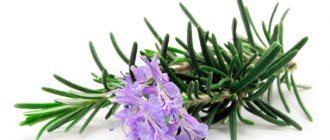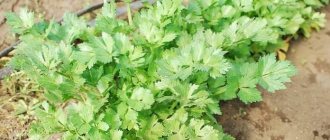How does rosemary overwinter?
For an evergreen subshrub, air temperature and light play an important role in the growing season. It is necessary to grow a perennial taking into account the fact that it feels comfortable when:
- loose soil without excess moisture;
- the soil is slightly alkaline or neutral;
- water regularly, but moderately;
- the area is well lit and protected from the wind.
But the main condition is the ambient temperature. In some regions it decreases greatly during winter, which is dangerous for rosemary. A shrub wintering in open ground may freeze if measures are not taken to protect it.
When the plant is young, it can be brought indoors. But as the bush grows, this becomes more difficult to do. In order for rosemary to successfully overwinter, it is necessary to carry out a number of measures to prepare it for wintering.
Main problems when growing
The main problem that a gardener may encounter is powdery mildew. Because of the peculiar leaves of rosemary, it does not manifest itself in the usual way. As a result of this, remaining unnoticed, the disease progresses and the plant dies from it. You can suspect a problem by browning leaves. Growing rosemary indoors can also be complicated by higher temperatures than it requires in winter, when the plant should be dormant.
Which varieties tolerate wintering easier?
Some of the most common types of rosemary are medicinal and prostrate. It is the latter type that serves as decoration for gardens. They love to plant it as a hedge. Growing, the bush fills the entire space. The result is a low, 0.5 meter fence of fragrant grass dotted with small blue flowers.
Of the prostrate varieties, it is better to choose lavender or creeping. Medicinal or common rosemary has different growth characteristics. It is distinguished by erect shoots with a height of 1 meter and above, and long narrow leaves. The bush is covered with flowers, lilac, violet, white, in early spring. The leaves and tops of shoots are used for medicinal purposes, using them as an infusion.
The essential oil obtained from the perennial is beneficial for elderly and weakened people.
Among the varieties of ordinary rosemary, Rosinka and Tenderness are suitable for temperate climates. It is better to plant them in pre-prepared soil, loose, nutritious, either with seeds or cuttings. In order not to dig up bushes each time for the winter, they are planted in a pot or tub and brought indoors before the air temperature begins to drop.
Preparing rosemary for winter
The onset of cold weather and freezing of the soil is an obstacle that can destroy an ornamental bush.
In order for rosemary to withstand unfavorable living conditions, it must be prepared for them, starting in spring:
- Close proximity to groundwater is dangerous for the plant. An evergreen perennial will be saved by good drainage, which will prevent the roots of the shrub from weakening and rotting.
- When flowering shoots grow on the site for more than one year, they need to be fed 1-2 times during the growing season. To do this, add up to 2 kilograms of humus or compost per square meter. After fertilizing, the soil is loosened to a depth of 5-10 centimeters.
- Mineral fertilizers also allow rosemary to strengthen before wintering. The complexes should contain potassium, nitrogen and phosphorus. These elements will strengthen the plant’s immunity and allow it to withstand the cold period.
- Pruning the bush during the active period of life will reduce the load on the plant and rejuvenate the crown. The cut branches have a place in the kitchen. They are added to various dishes and drinks.
- When the bush is still young, and the winter is expected to be harsh, it is better to replant the shoots in a pot and bring them indoors. The plant is well preserved at a temperature of 10 degrees Celsius.
See also
How to properly grow and care for rosemary in open ground in the middle zoneRead
Strong ornamental bushes with a stable immune system can survive the winter and produce new shoots in the spring.
Harvesting
Throughout the summer, you can pick the leaves from rosemary and add them to food. If the plant was moved indoors for the winter, then you can pamper yourself with fresh and fragrant herbs throughout the cold period.
For winter stocks there are some nuances in harvesting:
- During the flowering period of the bush, a small proportion of essential oils is observed in it. This period is optimal for winter preparations.
- Harvesting must be done exclusively in sunny and calm weather.
- Only young shoots are suitable for winter storage.
- The collected twigs can be hung dried in a well-ventilated room in a dark place.
- It is possible to dry the shoots using an oven, which will take less time.
- It is also permissible to chop the greens and only then dry them.
- To preserve the aroma and all the beneficial properties of the seasoning, it is recommended to store it in glass containers for about 3 years.
- In recent years, housewives have gotten used to freezing greens in bags or plastic containers, which is also an acceptable method and will preserve all the properties of the greens.
Should rosemary be pruned for the winter?
Pruning rosemary is mandatory, as it helps the bush take on a noble shape. In addition, you need to cut off those branches that are dry or damaged.
It is better to prune shoots during the period of active growth of the perennial. This time falls in March-April. And twigs cut in spring can be used as a seasoning or medicine.
There is no need to prune rosemary before preparing the bush for winter. After all, the plant will need strength to endure a difficult period of life. Pruning will only weaken the plant; it will not be able to recover after removing the shoots. The risk of death of a bush treated with pruning shears before wintering will increase several times.
Dig or cover: which method is better?
The delicate ornamental crop cannot tolerate even a slight drop in temperature. Therefore, in the fall, the gardener must determine what to do, how to reliably protect rosemary from the coming cold. And they do this not when the temperature has already dropped below 0 degrees.
In regions with warm, wet winters, rosemary bushes can be covered. Dry leaves, straw, and sawdust are suitable for this. Before sheltering, the bush is bent to the ground. If there are few shoots, they are pinned with wooden pins. You can limit the growth area with boards or shields. Dry natural material is poured into them and covered with film on top. Such a shelter will save the plant from the influence of low temperatures.
If the rosemary bush is young and has not grown much, it can be transplanted into a pot, placing it in a cool, bright room. The perennial will survive the dormant period well, and in the spring it will be ready to bloom in the garden.
But not all bushes can be dug up. If the bush has grown sufficiently, then it is better to cover it with improvised means. But in areas with cold climates, this method will not save rosemary from freezing. Therefore, growing in a container is the best option. Then in the spring they move the pot with the evergreen crop into the fresh air in the garden, and in the fall they bring it into the basement.
Where can you transplant rosemary for the winter?
The semi-shrub ornamental crop grows well in open ground, increasing in size every year. Rosemary shoots can reach a height of about a meter or more. At the same time, the number of leaves increases, and the shoots begin to become lignified. In this case, it is difficult to transplant the plant to another place.
See also
Planting and caring for rosemary in open groundRead
But when it is known that frosts will be within minus 10 degrees, the bush will die in any case, and no shelter will save it. It is urgent to prepare a warm room with optimal lighting. The container with the bush is transferred there and left for the winter.
Shoots dug out of the ground can be planted in a prepared container with nutritious and loose soil. It is necessary not to forget about the acidity of the soil. It is better to lime the soil so that rosemary survives the winter successfully.
After transplanting, you need to let the plant get stronger by watering it regularly. You should not keep a garden plant in the room. The ideal option for it would be a balcony, loggia or veranda. There will be plenty of light, and the air temperature will not drop below 5 degrees Celsius. Here the fragrant shoots will survive the winter and gain strength for the subsequent growing season.
How to plant and grow on a windowsill - features, conditions and step-by-step instructions
When growing rosemary on a windowsill, it is important to comply with all agrotechnical requirements. Only a bush growing in a favorable environment will serve as an interior decoration, a storehouse of nutrients and unique taste.
What should the place be like?
Before you acquire a spice plant, you need to familiarize yourself with its characteristics in advance. The information below will help determine whether rosemary will be able to create suitable conditions.
Temperature
The optimal temperature in the room where the pots of rosemary are located is +12-+16 C. Warmer environments are bad for spring blooms.
Important! Rosemary reacts to sudden temperature fluctuations by dropping its leaves.
Humidity
To prevent the plant from being affected by fungi, the air humidity in the apartment should be below average. Rosemary will grow quickly if the room is ventilated daily for 2-3 hours. In winter, air circulation can be achieved using a conventional fan.
The substrate in the pot should be constantly moist, but in no case wet. It is better to underwater the rosemary and allow the soil to dry out for a short time, rather than turn the soil mixture into a swamp.
Illumination
In order for rosemary to form leaves more actively, in winter the light-loving plant should be placed on a southern or eastern windowsill. In summer, the container with rosemary is transferred to the balcony or planted on the plot. The pot needs to be periodically turned to the light, first on one side or the other. In this way, deformation can be avoided when the plant bends to one side of the light, which often happens when growing light-loving plants on a windowsill.
On short winter days, rosemary responds gratefully to morning and evening additional illumination with fluorescent lamps.
What container to plant in?
Due to the fact that the root system of rosemary is highly branched, the plant should be planted in a spacious clay or terracotta pot. Optimal dimensions of the planting container: height 15-20 cm, width 25 cm. Deviations from the recommended values downward by 3-5 cm are allowed.
In what soil (substrate)
To plant rosemary on a windowsill in an apartment, buy neutral or slightly alkaline soil for growing seedlings. Instead of purchased soil, you can use a mixture of garden soil and sand. The main condition is that the soil must be loose and breathable. Before planting, the bottom of the pot is laid with a layer of drainage, through which excess water will flow into the pan.
Preparing seeds or cuttings for planting
Rosemary seeds To speed up the emergence of seedlings, on the eve of planting, the seeds are soaked for 24 hours in water or a growth stimulant.
Preparing rosemary cuttings for subsequent cultivation on a windowsill is carried out in the following sequence:
- In late spring, on a healthy bush, the tops of young shoots 8-10 cm long are cut off.
- Planting material is cleared of foliage
- The cut sites are dipped in a growth stimulator, thanks to which roots form faster.
Direct landing
All preparatory work will be useless if the landing is incorrect. The procedure depends on the type of planting material.
seeds are sown as follows:
- Planting material is evenly laid out over a container filled with a damp substrate. Please note that due to poor germination of seeds, you need twice as many seedlings as planned.
- Sprinkle them on top with a 0.5 cm layer of damp soil.
- The container with the crops is covered with glass or film and placed in a warm place where the temperature is +25-+30C. Lighting doesn't matter at this stage.
- As soon as the seedlings hatch, the box is gradually opened and transferred to a bright place. If necessary, moisten the substrate using a spray bottle.
Planting cuttings for growing on a windowsill is done as follows:
- To prepare the substrate, sand is mixed with peat moss.
- Prepared cuttings are buried in the soil at an angle of 30-45 degrees.
- Cover the container with film and make holes in it to allow fresh air to flow to the cuttings.
- The box is placed in a warm, bright place. The mini greenhouse needs to be periodically opened and sprayed.
- At 3-4 weeks of age, the new plants can be transplanted into a permanent pot.
Video: features and difficulties of growing rosemary in a pot at home
Caring for rosemary in winter
It's easy to care for medicinal perennials at home. Care activities include:
- watering to prevent the soil in the pot from drying out;
- one-time fertilizing with organic or mineral fertilizers;
- control of air temperature not higher than 8-10 degrees Celsius and humidity at 75 percent;
- fresh air flow with protection from drafts.
Those rosemary bushes that remain in the garden or country house must also be looked after in order to preserve the valuable crop.
In the garden
To protect rosemary grown in the garden, it must be carefully prepared for wintering. In addition to reliable shelter, the shrub needs loose soil so that there is enough moisture and air for the long winter. The soil must have enough nutrients to help the plant survive difficult times.
If there is good shelter, it is necessary to check the condition of the bushes and ventilate the plantings on warm days of winter. An influx of fresh cool air will give the plant strength and save it from rotting and fungal infections.
In the open ground
Anyone who leaves a rosemary bush in the ground for the winter must provide it with warmth. In addition to covering with straw, spruce branches, and dry leaves, you need to hide the plantings under the snow. Therefore, before planting a heat-loving crop, you need to choose a site for the plant where more snow accumulates and is not blown away by the winds. The snowdrift retains heat throughout the winter, which helps prevent rosemary from dying.
In the country
Before growing heat-loving rosemary on a plot, summer residents need to know the rules for caring for it and the conditions for keeping it during the cold season. It is advisable to plant the plant in a pot to place it in the basement or on the veranda in October, providing enough light. Given the short duration of daylight in winter, it is necessary to install fluorescent lamps in the room. By hanging them at a level of 30-40 centimeters from the rosemary, they provide the plant with the opportunity to prepare for the growing season and flowering.
It is necessary to water the bush rarely, coming to the dacha 2-3 times a month. Rosemary almost does not need fertilizing. If care was correct during the active season, then the plant will have enough nutrition for the entire winter.
You can leave the perennial in the ground for the winter if the dacha is located in an area with a temperate climate . Then a shelter made of natural materials will allow the ornamental shrub to calmly survive the cold and frost.
Diseases and pests
Rosemary is highly resistant to diseases and harmful insects. It has infections such as root rot, downy mildew and powdery mildew. Bushes are affected by whiteflies, spider mites and aphids.
Root rot
The causative agent of the disease is fungi. Their growth and reproduction occurs most rapidly at a temperature of 18–28°C in combination with high humidity and insufficient air supply to the soil. At the first signs of disease, it is necessary to reduce, and in many cases completely stop, watering the plant for a while. Loosen the top layer of soil and spray the bush and soil with a fungicide that inhibits the development of the pathogen, for example Previkur, Ridomil or Fundazol.
Downy mildew
This disease is also called downy mildew. Its causative agent is pseudofungi belonging to the class of oomycetes. They attack leaves and shoots at high air humidity and significant temperature changes. The pathogen can survive in the soil for several years and infect plant seeds. The first signs of the disease are small yellow dots on the leaves, after some time drops of moisture and a gray-violet coating appear.
This leads first to necrosis of individual sections of the leaves, and then to their drying out. To destroy the pathogen, the affected branches are cut and burned, and the seeds are treated with fungicides before planting. Bushes should be sprayed with Quadris, Ridomil or another drug with antifungal activity only in extreme cases and very carefully.
Greens cannot be used for food after this treatment.
Powdery mildew
Caused by ectoparasitic fungi. The presence of the disease is indicated by the appearance of a white coating on the leaves and shoots. Over time, fungal spores mature and drops resembling dew form in these places. Shoots located in close proximity to the soil surface are primarily affected. High temperature and humidity contribute to the rapid spread of infection.
To prevent the disease, it is recommended to thin out the crown of the bush to allow fresh air to access the stems and leaves.
Diseased parts of the plant are cut off and burned. The soil is fertilized with a preparation containing phosphorus and potassium. To destroy pathogens, treatment with colloidal sulfur is used.
Whitefly
Recommended by topic
Catharanthus Hamedorea Cinquefoil
An insect no more than 3 mm long. The body and wings are white, the surface is strewn with small particles resembling flour. Often found on the underside of leaf blades. They can lead to the death of the plant by sucking the juice out of it.
Whitefly damage to rosemary is indicated by:
- the presence of small white midges on the leaves;
- transparent formations on the reverse side of the leaf blades (deposited by whitefly larvae);
- the appearance of yellow spots and sticky substance (waste secreted by midges);
- stopping the growth of bush shoots.
To combat whiteflies, spray the plant with tobacco infusion, soap or alcohol solution.
If these safe remedies are ineffective, the bushes are treated with an insectoacaricidal preparation, for example Iskra or Fitoverm.
Spider mite
Very small insects. They have different colors depending on the type of tick. They feed on plant sap, causing the death of leaf cells. Infestation of rosemary by spider mites is indicated by a large number of small dots on the back of the leaf and cobwebs on the vegetative parts of the plant. After some time, the color of the leaves fades, they dry out and fall off. To destroy the pest, use a solution of laundry soap, and in advanced cases, use insecticides, such as Aktar or Decis.
Aphid
Insects are green in color with a body length of no more than 5 mm. They feed on plant sap by piercing the leaf with their proboscis. In this case, a toxic substance enters the leaves, leading to the growth of the shoot stopping, curling and death of the leaves. Aphids secrete large amounts of honeydew, a sweet liquid that ants and other insects feed on.
Ladybug is a natural enemy of aphids
To destroy aphids, the bushes are irrigated with water, sprayed with an ash-soap solution, infusion of garlic, tobacco, onion, and chamomile. Some plants with a rich aroma repel aphids, so it is recommended to plant rosemary next to marigolds, lavender, mint, and basil.
The use of chemicals (Confidors, Aktars, etc.) is undesirable, since pesticides pollute the soil and accumulate in the stems and leaves of plants. Eating such greens is dangerous for humans and can lead to poisoning of the body.











